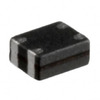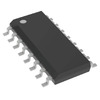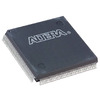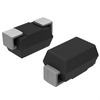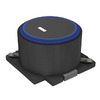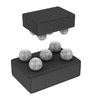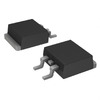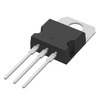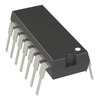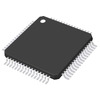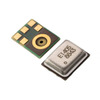DRV8870DDAR Comprehensive Guide: High Efficiency Brushed DC Motor Driver
Catalog
Overview of DRV8870DDAR

The DRV8870DDAR is a 3.6A brushed DC motor driver in an 8-pin SO PowerPAD package. It is designed for printers, appliances, industrial equipment, and other small machines to provide stable and efficient motor control. The driver uses two logic inputs to control its internal H-bridge circuit, which is composed of four N-channel MOSFETs and is capable of bidirectional control of the motor and supports peak currents up to 3.6A. In terms of controlling motor speed, the DRV8870DDAR accepts PWM input, allowing users to select current attenuation mode to accurately adjust motor speed. Additionally, when both inputs are set low, the driver enters a low-power sleep mode to save energy and extend the life of the device.
It features integrated current regulation based on the voltage on the analog input VREF and ISEN pins, which is proportional to the motor current through the external sense resistor. This current limiting capability controls current flow to a known level, significantly reducing system power requirements and reducing the bulk capacitance required to maintain stable voltage, especially during motor starting and stalling. In addition, the device features comprehensive protection against faults and short-circuit conditions such as undervoltage, overcurrent, and overtemperature. It can drive a DC motor, a winding of a stepper motor or other loads and operate stably within a wide operating voltage range of 6.5V to 45V. Its typical RDS(on) is 565mΩ (HS+LS), the peak current is up to 3.6A, and it is equipped with a PWM control interface to facilitate users to accurately control the motor speed. At the same time, the driver also integrates current regulation functions and has a low-power sleep mode to further save energy.
Alternatives and equivalents:
Device Functional Modes
The DRV8870DDAR device can be used in multiple ways to drive a brushed DC motor.
VM Control
In some systems, varying VM as a means of changing motor speed is desirable.
Static Inputs with Current Regulation
The IN1 and IN2 pins can be set high and low for 100 percent duty cycle drive, and ITRIP can be used to control the current of the motor, speed, and torque capability.
PWM with Current Regulation
This scheme uses all of the capabilities of the device. The ITRIP current is set above the normal operating current, and high enough to achieve an adequate spin-up time, but low enough to constrain current to a desired level. Motor speed is controlled by the duty cycle of one of the inputs, while the other input is static. Brake or slow decay is typically used during the off-time.
PWM without Current Regulation
If current regulation is not required, the ISEN pin should be directly connected to the PCB ground plane. The VREF voltage must still be 0.3V to 5 V, and larger voltages provide greater noise margin. This mode provides the highest-possible peak current which is up to 3.6 A for a few hundred milliseconds (depending on PCB characteristics and the ambient temperature). If current exceeds 3.6 A, the device might reach overcurrent protection (OCP) or overtemperature shutdown (TSD). If that happens, the device disables and protects itself for about 3 ms (tRETRY) and then resumes normal operation.
Technical Parameters of DRV8870DDAR
• Part Status: Active
• Manufacturer: Texas Instruments
• Package / Case: SO-PowerPad-8
• Packaging: Tape and Reel
• Number of Outputs: 2 Outputs
• Operating Frequency: 100 kHz
• Operating Supply Current: 3 mA
• Operating Supply Voltage: 6.5 V to 45 V
• Operating Temperature: - 40°C ~ 125°C
• Pin Count: 8
• Mounting Style: SMD/SMT
• Output Configuration: H-Bridge
• Product Category: Motor / Motion / Ignition Controllers & Drivers
What Are the Power Consumption Characteristics of DRV8870DDAR?
The DRV8870DDAR has the following power consumption characteristics:
Temperature Characteristics: The temperature characteristics of the driver will also have an impact on its power consumption. In high-temperature environments, the internal resistance of the device increases, resulting in additional power consumption. Therefore, DRV8870DDAR usually provides power consumption parameters under different temperature conditions in the data sheet so that users can have a more accurate understanding of its performance in actual applications.
Dynamic Power Consumption: Dynamic power consumption depends on the output current, drive voltage and load characteristics of the motor. Dynamic power consumption will increase when the workload is heavy or frequent starts, stops, and speed changes are required. However, the DRV8870DDAR is usually designed as a high-efficiency driver, so its dynamic power consumption is generally controlled at a low level.
Static Power Consumption: The static power consumption of DRV8870DDAR is very low, usually in the range of a few milliwatts to tens of milliwatts. This means that the drive itself consumes very little energy, even when the motor is not running or under light load.
Efficiency: DRV8870DDAR has a high-efficiency design and is usually able to work between 85 percent and 95 percent. High efficiency means that the drive has a high ability to convert input electrical energy into mechanical output power, thereby reducing energy waste and heat generation.
DRV8870DDAR Circuit Diagram

Power Supply Recommendations of DRV8870DDAR
Ensuring sufficient local bulk capacitance stands as a pivotal consideration in motor drive system design. Greater bulk capacitance typically yields advantages, yet the trade-offs encompass escalated expenses and enlarged physical dimensions.
The amount of local capacity needed depends on a variety of factors, including:
• The motor braking method
• The acceptable voltage ripple
• The highest current required by the motor system
• The type of motor used (brushed DC, brushless DC, stepper)
• The capacity of the power supply and ability to source current
• The amount of parasitic inductance between the power supply and motor system
The inductance between the power supply and motor drive system limits how the rate current can change from the power supply. If the local bulk capacitance is too small, the system responds to excessive current demands or dumps from the motor with a change in voltage. When adequate bulk capacitance is used, the motor voltage remains stable and high current can be quickly supplied. The data sheet generally provides a recommended value, but system-level testing is required to determine the appropriate sized bulk capacitor.

The voltage rating for bulk capacitors should be higher than the operating voltage, to provide margin for cases when the motor transfers energy to the supply.
Functional Features of DRV8870DDAR
DRV8870DDAR has following features:
Wide Input Voltage Range: The input voltage range of DRV8870DDAR is 3.8V to 36V, which is suitable for a variety of different power supply application scenarios.
PWM Control: DRV8870DDAR supports pulse width modulation (PWM) control, which can achieve precise speed and steering control of the motor by adjusting the frequency and duty cycle of PWM.
Low Power Consumption: DRV8870DDAR has low power consumption characteristics under no-load or low-load conditions. It can achieve energy-saving operation and reduce system energy consumption by controlling the size of the current.
High Integration: DRV8870DDAR has a highly integrated design, reducing the number and size of external components. It also contains a built-in power supply voltage regulator that can provide power supply regulation functions required by external circuits.
Double H-Bridge Structure: DRV8870DDAR adopts a double H-bridge drive structure, which can control forward and reverse rotation, acceleration and deceleration and other movements. It can realize bidirectional control of the motor, allowing the motor to move forward, backward and brake.
Multiple Interface Options: DRV8870DDAR provides multiple interface options, including SPI, I2C and UART, etc. This allows it to communicate with different controllers and microprocessors for more flexible and convenient system integration.
High Current Driving Capability: DRV8870DDAR can provide current output up to 3.6A, which can be used to drive motors or loads that require high current. This makes it suitable for various industrial applications and scenarios such as robots that require strong driving force.
Built-in Protection Functions: DRV8870DDAR has a variety of built-in protection functions, including over-current protection, over-temperature protection, short-circuit protection and low-voltage protection. These protection functions can effectively avoid damage to equipment and motors and improve system reliability and safety.
What Interface Options Does DRV8870DDAR Provide?
DRV8870DDAR provides a variety of interface options, its main interfaces include:
Direction Control Input
DRV8870DDAR provides an interface for controlling the direction of motor movement. It indicates the forward or reverse rotation of the motor by inputting a logic high level or a logic low level. The direction control input is typically connected to a digital output pin of a microcontroller or other control device.
Fault Diagnosis Output
The DRV8870DDAR also provides fault diagnostic output to indicate driver operating status or detect faults. For example, fault diagnostic outputs can be used to indicate fault conditions such as overcurrent, overtemperature, or undervoltage. These signals are typically connected to digital input pins of a microcontroller or other monitoring device.
PWM Input
DRV8870DDAR supports PWM (Pulse Width Modulation) input for controlling the speed and direction of the motor. By adjusting the duty cycle of the PWM input signal, the speed of the output motor can be controlled. The PWM input is typically connected to the PWM output pin of a microcontroller or other digital output device.
Enable Input
The enable input is used to enable or disable the motor driver. When the enable input is at a logic high level, the driver is in an enabled state and can drive the motor; when the enable input is at a logic low level, the driver is in a disabled state and the motor stops working. The enable input is typically connected to a digital output pin of a microcontroller or other control device.
Frequently Asked Questions [FAQ]
1. What is the H-bridge motor driver?
H-bridge drivers are a long established means for enabling bidirectional motor driving. By using one, rotation of the motor can be driven, and the polarity of the supply to the motor can be swapped in order to change the direction of rotation. It can also take care of braking, when this is required.
2. What is the replacement and equivalent of DRV8870DDAR?
You can replace the DRV8870DDAR with DRV8870DDA, DRV8871DDA, DRV8871DDAR or DRV8872DDA.
3. What is the purpose of the integrated charge pump in the DRV8870DDAR?
The integrated charge pump in the DRV8870DDAR allows it to operate from a single power supply, simplifying the overall system design.
4. What protection features does the DRV8870DDAR offer?
The DRV8870DDAR provides several protection features, including overcurrent protection (OCP), overtemperature protection (OTP), undervoltage lockout (UVLO), and fault reporting.
About us
ALLELCO LIMITED
Read more
Quick inquiry
Please send an inquiry, we will respond immediately.

LM331 Comprehensive Guide: Precision Voltage to Frequency Converters
on August 28th

ADUM1200ARZ Technology Insight: Performance, Efficiency and Applications
on August 28th
Popular Posts
-

What is GND in the circuit?
on January 1th 3036
-

RJ-45 Connector Guide: RJ-45 Connector Color Codes, Wiring Schemes, R-J45 Applications, RJ-45 Datasheets
on January 1th 2607
-

Fiber Connector Types: SC Vs LC And LC Vs MTP
on January 1th 2162
-

Understanding Power Supply Voltages in Electronics VCC, VDD, VEE, VSS, and GND
on November 13th 2067
-

Comparison Between DB9 and RS232
on January 1th 1789
-

What Is An LR44 Battery?
Electricity, that ubiquitous force, quietly permeates every aspect of our daily lives, from trivial gadgets to life-threatening medical equipment, it plays a silent role. However, truly grasping this energy, especially how to store and efficiently output it, is no easy task. It is against this background that this article will focus on a type of coin cell battery that may seem insignificant on the...on January 1th 1754
-

Understanding the Fundamentals:Inductance Resistance, andCapacitance
In the intricate dance of electrical engineering, a trio of fundamental elements takes center stage: inductance, resistance, and capacitance. Each bears unique traits that dictate the dynamic rhythms of electronic circuits. Here, we embark on a journey to decipher the complexities of these components, to uncover their distinct roles and practical uses within the vast electrical orchestra. Inductan...on January 1th 1704
-

CR2430 Battery Comprehensive Guide: Specifications, Applications and Comparison to CR2032 Batteries
What is CR2430 battery ?Benefits of CR2430 BatteriesNormCR2430 Battery ApplicationsCR2430 EquivalentCR2430 VS CR2032Battery CR2430 SizeWhat to look for when buying the CR2430 and equivalentsData Sheet PDFFrequently Asked Questions Batteries are the heart of small electronic devices. Among the many types available, coin cells play a crucial role, commonly found in calculators, remote controls, and ...on January 1th 1640
-

What Is RF and Why Do We Use It?
Radio Frequency (RF) technology is a key part of modern wireless communication, enabling data transmission over long distances without physical connections. This article delves into the basics of RF, explaining how electromagnetic radiation (EMR) makes RF communication possible. We will explore the principles of EMR, the creation and control of RF signals, and their wide-ranging uses. The article ...on January 1th 1620
-

Comprehensive guide to hFE in transistors
Transistors are crucial components in modern electronic devices, enabling signal amplification and control. This article delves into the knowledge surrounding hFE, including how to select a transistor's hFE value, how to find hFE, and the gain of different types of transistors. Through our exploration of hFE, we gain a deeper understanding of how transistors work and their role in electronic circu...on November 13th 1562


